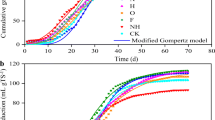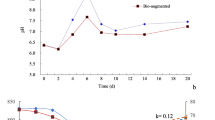Abstract
This study investigated the effects of different bulking agents (i.e., sawdust, wheat straw, rice straw, and corncob) on bacterial structure and functions for organic degradation during food waste in-situ rapid biological reduction (IRBR) inoculated with microbial agent. Results showed that the highest organic degradation (409.5 g/kg total solid) and volatile solids removal efficiency (41.0%) were achieved when wheat straw was used, largely because the degradation of readily degradable substrates and cellulose was promoted by this bulking agent. Compared with other three bulking agents, the utilization of wheat straw was conducive to construct a more suitable environmental condition (moisture content of 18.0–28.2%, pH of 4.91–5.87) for organic degradation during IRBR process, by virtue of its excellent structural and physiochemical properties. Microbial community analysis suggested that the high-moisture environment in rice straw treatment promoted the growth of Staphylococcus and inhibited the activity of the inoculum. By contrast, lowest bacterial richness was observed in corncob treatment due to the faster water loss. Compared with these two bulking agents, sawdust and wheat straw treatment led to a more stable bacterial community structure, and the inoculated Bacillus gradually became the dominant genus (36.6–57.8%) in wheat straw treatment. Predicted metagenomics analysis showed that wheat straw treatment exhibited the highest carbohydrate metabolism activity which improved the pyruvate, amino sugar and nucleotide sugar metabolism, and thereby promoted the organic degradation and humic substrate production. These results indicated that wheat straw was a more desirable bulking agent, and revealed the potential microbial organics degradation mechanism in IRBR process.






Similar content being viewed by others
References
Jonge Nd, Davidsson Å, JlC J, Nielsen JL (2020) Characterisation of microbial communities for improved management of anaerobic digestion of food waste. Waste Manag 117:124–135. https://doi.org/10.1016/j.wasman.2020.07.047
Yin Y, Liu Y, Meng S, Kiran EU, Liu Y (2016) Enzymatic pretreatment of activated sludge, food waste and their mixture for enhanced bioenergy recovery and waste volume reduction via anaerobic digestion. Appl Energy 179:1131–1137. https://doi.org/10.1016/j.apenergy.2016.07.083
He P, Zhao L, Zheng W, Wu D, Shao L (2013) Energy balance of a biodrying process for organic wastes of high moisture content: a review. Dry Technol 31:132–145. https://doi.org/10.1080/07373937.2012.693143
Yuan J, Li Y, Zhang H, Zhang D, Chadwick D, Li G, Wang G, Chi M, Yang F (2018) Effects of adding bulking agents on the biodrying of kitchen waste and the odor emissions produced. J Environ Sci 67:344–355. https://doi.org/10.1016/j.jes.2017.08.014
Xu FQ, Li YY, Ge XM, Yang LC, Li Y (2018) Anaerobic digestion of food waste - Challenges and opportunities. Bioresour Technol 247:1047–1058. https://doi.org/10.1016/j.biortech.2017.09.020
FAO (2019) Food loss and food waste. Food and Agriculture Organization of the United Nations
Agapiou A, Vamvakari JP, Andrianopoulos A, Pappa A (2016) Volatile emissions during storing of green food waste under different aeration conditions. Environ Sci Pollut Res 23:8890–8901. https://doi.org/10.1007/s11356-016-6131-5
Kucbel M, Raclayska H, Ruzickova J, Svedova B, Sassmanova V, Drozdova J, Raclaysky K, Juchelkova D (2019) Properties of composts from household food waste produced in automatic composters. J Environ Manage 236:657–666. https://doi.org/10.1016/j.jenvman.2019.02.018
UK House of Commons report. The 2001 Outbreak of Foot and Mouth Disease. Report by the Comptroller and Auditor General (No. HC 939) (2002) London
Aydin AE, Yildirim P (2021) Understanding food waste behavior: the role of morals, habits and knowledge. J Clean Prod 280:124250. https://doi.org/10.1016/j.jclepro.2020.124250
Waqas M, Almeelbi T, Nizami AS (2018) Resource recovery of food waste through continuous thermophilic in-vessel composting. Environ Sci Pollut Res 25:5212–5222. https://doi.org/10.1007/s11356-017-9358-x
General Office of the State Council of the People's Republic of China (2012) http://www.gov.cn/zhengce/content/2012-05/05/content_5109.htm
Lv F, Zhang H, Hao L, Shao L, He P (2020) Analysis on the treatment technology of organic fraction of municipal solid waste in the neighborhood or on-site. Environ Sanit Eng 28:1–7. https://doi.org/10.19841/j.cnki.hjwsgc.2020.05.001
Zhou S, Zhou H, Xia S, Ying J, Ke X, Zou S, Xue Y, Zheng Y (2021) Efficient bio-degradation of food waste through improving the microbial community compositions by newly isolated Bacillus strains. Bioresour Technol 321:124451. https://doi.org/10.1016/j.biortech.2020.124451
Yeo J, Oh JI, Cheung HHL, Lee PKH, An AK (2019) Smart food waste recycling bin (S-FRB) to turn food waste into green energy resources. J Environ Manag 234:290–296. https://doi.org/10.1016/j.jenvman.2018.12.088
Mohammed M, Ozbay I, Karademir A, Isleyen M (2017) Pre-treatment and utilization of food waste as energy source by bio-drying process. Energy Proc 128:100–107. https://doi.org/10.1016/j.egypro.2017.09.021
Cerda A, Artola A, Font X, Barrena R, Gea T, Sanchez A (2018) Composting of food wastes: status and challenges. Bioresour Technol 248:57–67. https://doi.org/10.1016/j.biortech.2017.06.133
Kumar M, Ou YL, Lin JG (2010) Co-composting of green waste and food waste at low C/N ratio. Waste Manag 30:602–609. https://doi.org/10.1016/j.wasman.2009.11.023
Li Z, Lu H, Ren L, He L (2013) Experimental and modeling approaches for food waste composting: a review. Chemosphere 93:1247–1257. https://doi.org/10.1016/j.chemosphere.2013.06.064
Thomas C, Idler C, Ammon C, Amon T (2020) Effects of the C/N ratio and moisture content on the survival of ESBL-producing Escherichia coli during chicken manure composting. Waste Manag 105:110–118. https://doi.org/10.1016/j.wasman.2020.01.031
Guardia Ad, Petiot C, Rogeau D (2008) Influence of aeration rate and biodegradability fractionation on composting kinetics. Waste Manag 28:73–84. https://doi.org/10.1016/j.wasman.2006.10.019
Guidoni LLC, Marques RV, Moncks RB, Botelho FT, da Paz MF, Correa LB, Correa EK (2018) Home composting using different ratios of bulking agent to food waste. J Environ Manag 207:141–150. https://doi.org/10.1016/j.jenvman.2017.11.031
Zhang L, Sun XY (2016) Influence of bulking agents on physical, chemical, and microbiological properties during the two-stage composting of green waste. Waste Manag 48:115–126. https://doi.org/10.1016/j.wasman.2015.11.032
Ma J, Zhang L, Mu L, Zhu K, Li A (2019) Multivariate insights of bulking agents influence on co-biodrying of sewage sludge and food waste: process performance, organics degradation and microbial community. Sci Total Environ 681:18–27. https://doi.org/10.1016/j.scitotenv.2019.05.101
Cai L, Chen TB, Gao D, Yu J (2016) Bacterial communities and their association with the bio-drying of sewage sludge. Water Res 90:44–51. https://doi.org/10.1016/j.watres.2015.12.026
Tortosa G, Fernández-González AJ, Lasa AV, Aranda E, Torralbo F, González-Murua C, Fernández-López M, Benítez E, Bedmar EJ (2021) Involvement of the metabolically active bacteria in the organic matter degradation during olive mill waste composting. Sci Total Environ 789:147975. https://doi.org/10.1016/j.scitotenv.2021.147975
Tortosa G, Castellano-Hinojosa A, Correa-Galeote D, Bedmar E (2017) Evolution of bacterial diversity during two-phase olive mill waste (“alperujo”) composting by 16S rRNA gene pyrosequencing. Bioresour Technol 224:101–111. https://doi.org/10.1016/j.biortech.2016.11.098
Awasthi S, Wong J, Li J, Wang Q, Zhang Z, Kumar S, Awasthi M (2018) Evaluation of microbial dynamics during post-consumption food waste composting. Bioresour Technol 251:181–188. https://doi.org/10.1016/j.biortech.2017.12.040
Xu Z, Ma Y, Zhang L, Han Y, Yuan J, Li G, Luo W (2021) Relating bacterial dynamics and functions to gaseous emissions during composting of kitchen and garden wastes. Sci Total Environ 767:144210. https://doi.org/10.1016/j.scitotenv.2020.144210
Zhang C, Gao Z, Shi W, Li L, Tian R, Huang J, Lin R, Wang B, Zhou B (2020) Material conversion, microbial community composition and metabolic functional succession during green soybean hull composting. Bioresour Technol 316:123823. https://doi.org/10.1016/j.biortech.2020.123823
MEEPRC (Ministry of Ecology and Environment of the People’s Republic of China) (2012) HJ634–2012. China Standards Press
APHA (1998) Standard methods for the examination of water and wastewater, 20th edn. American Public Health Association, Washington, DC
Horwitz W (2005) Official methods of analysis of AOAC International, 18th edn. AOAC International Champaign, Illinois
Nielsen (2002) Food analysis. China Light Industry Press, Beijing
Goering HK, van Soest PJ (1970) Forage fiber analyses. USDA Agricultural Handbook No. 379
Zhang D, He P, Jin T, Shao L (2008) Bio-drying of municipal solid waste with high water content by aeration procedures regulation and inoculation. Bioresour Technol 99:8796–8802. https://doi.org/10.1016/j.biortech.2008.04.046
Sarifudin A, Keeratiburana T, Soontaranon S, Tangsathitkulchai C, Tongta S (2020) Pore characteristics and structural properties of ethanol-treated starch in relation to water absorption capacity. LWT Food Sci Technol. https://doi.org/10.1016/j.lwt.2020.109555
Yang B, Zhang L, Jahng D (2014) Importance of initial moisture content and bulking agent for biodrying sewage sludge. Dry Technol 32:135–144. https://doi.org/10.1080/07373937.2013.795586
Zhou Y, Selvam A, Wong JWC (2018) Chinese medicinal herbal residues as a bulking agent for food waste composting. Bioresour Technol 249:182–188. https://doi.org/10.1016/j.biortech.2017.09.212
Wang X, Selvam A, Chan MT, Wong JWC (2013) Nitrogen conservation and acidity control during food wastes composting through struvite formation. Bioresour Technol 147:17–22. https://doi.org/10.1016/j.biortech.2013.07.060
Ma J, Zhang L, Mu L, Zhu K, Li A (2019) Energetic enhancement of thermal assistance in the cooling stage of biodrying by stimulating microbial degradation. Waste Manag 89:165–176. https://doi.org/10.1016/j.wasman.2019.04.004
Hao Z, Jahng D (2019) Variations of organic matters and extracellular enzyme activities during biodrying of dewatered sludge with different bulking agents. Biochem Eng J 147:126–135. https://doi.org/10.1016/j.bej.2019.04.001
Shah AT, Favaro L, Alibardi L, Cagnin L, Sandon A, Cossu R, Casella S, Basaglia M (2016) Bacillus sp strains to produce bio-hydrogen from the organic fraction of municipal solid waste. Appl Energy 176:116–124. https://doi.org/10.1016/j.apenergy.2016.05.054
Wu J, Zhao Y, Qi H, Zhao X, Yang T, Du Y, Zhang H, Wei Z (2017) Identifying the key factors that affect the formation of humic substance during different materials composting. Bioresour Technol 244:1193–1196. https://doi.org/10.1016/j.biortech.2017.08.100
Roy A, Dutta A, Pal S, Gupta A, Sarkar J, Chatterjee A, Saha A, Sarkar P, Sar P, Kazy SK (2018) Biostimulation and bioaugmentation of native microbial community accelerated bioremediation of oil refinery sludge. Bioresour Technol 253:22–32. https://doi.org/10.1016/j.biortech.2018.01.004
Li M, He X, Tang J, Li X, Zhao R, Tao Y, Wang C, Qiu Z (2021) Influence of moisture content on chicken manure stabilization during microbial agent-enhanced composting. Chemosphere 264:128549. https://doi.org/10.1016/j.chemosphere.2020.128549
Author information
Authors and Affiliations
Contributions
S-PZ data curation, formal analysis, investigation, methodology, writing–original draft. H-YZ methodology, formal analysis, writing–review and editing. J-CS formal analysis, methodology, investigation. CL methodology, investigation. XK methodology. S-PZ methodology. Y-PX conceptualization, funding acquisition, methodology, resources, project administration, supervision. Y-GZ funding acquisition, supervision.
Corresponding author
Ethics declarations
Conflict of interest
The authors declare no financial or commercial conflict of interest.
Additional information
Publisher's Note
Springer Nature remains neutral with regard to jurisdictional claims in published maps and institutional affiliations.
Supplementary Information
Below is the link to the electronic supplementary material.
Rights and permissions
About this article
Cite this article
Zhou, SP., Zhou, HY., Sun, JC. et al. Bacterial dynamics and functions driven by bulking agents to enhance organic degradation in food waste in-situ rapid biological reduction (IRBR). Bioprocess Biosyst Eng 45, 689–700 (2022). https://doi.org/10.1007/s00449-022-02688-x
Received:
Accepted:
Published:
Issue Date:
DOI: https://doi.org/10.1007/s00449-022-02688-x




